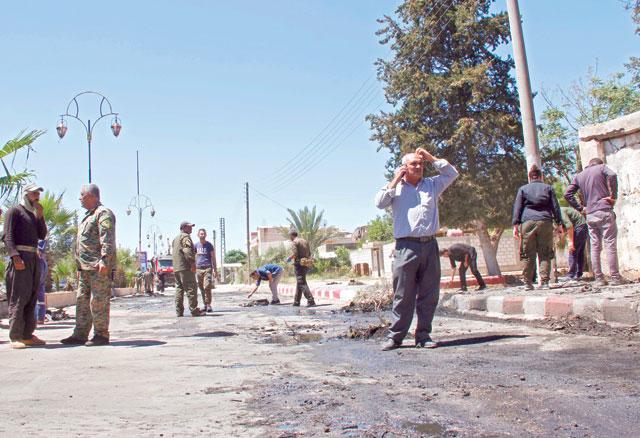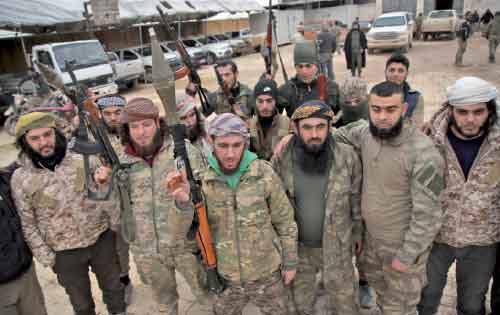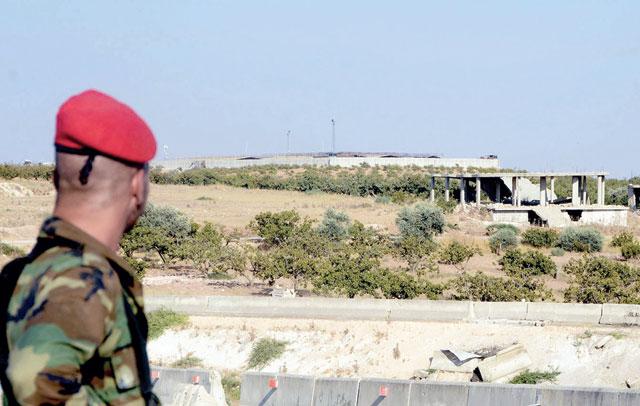You are here
Syria buffer zone, sought by Turkey since start of war
By AFP - Aug 08,2019 - Last updated at Aug 08,2019

A fighter from the former Al Qaeda Syrian affiliate Hayat Tahrir Al Sham fires an anti-aircraft gun mounted on a pickup truck in Syria’s southern Idlib province on Wednesday (AFP photo)
BEIRUT — Since the start of the Syrian conflict, Turkey has pushed for a buffer zone on their shared border to handle refugees and thwart the emergence of an autonomous Kurdish region.
Turkish and US officials agreed on Wednesday to establish a joint centre to look into establishing such a zone, which they called a “peace corridor”, even though Damascus is strongly opposed.
Here is an overview of plans for a buffer area, which would be located on the Syrian side of the border.
Humanitarian protection
In November 2011, just months into Syria’s devastating conflict, Turkish Foreign Minister Ahmet Davutoglu mooted the creation of a border buffer, with international backing, in case of a massive outflow of refugees into Turkey.
The Syrian National Council, the main opposition coalition at the time, had also raised the idea of a no-fly zone or secure area to protect civilians fleeing the regime’s crackdown.
Against the Kurds
In July 2012, Turkey was furious when the Syrian army withdrew from parts of the north where Kurdish militants — its foes — were deployed.
Recep Tayyip Erdogan, then prime minister, accused Damascus of having “allotted” these areas to the Kurds, which Turkey fears are seeking autonomy.
It sees Syria’s Kurdish forces as a “terrorist” offshoot of the Kurdistan Worker’s Party which has for decades waged a deadly insurgency in Turkey.
Erdogan said he would consider creating a military buffer zone on the border.
In August 2012, Davutoglu urged the UN Security Council to set up civilian safe-havens inside Syria, saying Ankara was struggling to cope with the thousands of people crossing into Turkey each day.
But UN officials and major powers said such camps would face major diplomatic, legal and military hurdles.
Free of ‘terrorism’
Turkey’s next foreign minister, Mevlut Cavusoglu, said in October 2014 that a buffer was needed to defeat Daesh terrorists as well as for humanitarian reasons.
The idea met with a guarded international response.
In November 2015, Erdogan again called on world leaders to rally behind “a safe zone cleared of terror”, implying it would be rid of both Daesh and Syrian Kurdish fighters.
In February 2017, he said the aim was to establish an area of at least 4,000 square kilometres “free from terrorism”.
US-Turkey agreement
President Donald Trump’s shock December 2018 announcement that the bulk of US troops would be withdrawn from Syria was welcomed by Turkey.
But the two quickly fell into a row over the future of Kurdish forces, a key US ally in the fight against IS.
In January 2019, Trump for the first time suggested a safe zone along the border, Turkey quickly affirming it would be able to handle this alone.
Damascus said it would be an infringement of its sovereignty.
In late July, US and Turkish officials opened negotiations to hammer out details of a safe zone, each side having different ideas.
Considering the US proposals would not keep the Kurdish group far enough away from Turkey’s border, Erdogan on August 6 threatened an operation “very soon” to “eliminate” the US-backed Kurdish People’s Protection Units.
The following day, both sides announced they had agreed to a “joint operations centre” to work on creating the safe zone.
They gave no details but described it as a “peace corridor”.
Damascus again voiced its rejection of the proposed zone while Syria’s Kurds gave a guarded welcome.
Related Articles
DAMASCUS — Damascus said on Thursday it strongly rejects a proposed US-Turkish buffer zone for northern Syria, blaming the "aggressive" proj
BEIRUT — Since the start of the Syrian conflict, Turkey has pushed for the creation of a buffer zone on its border to protect refugees and p
QAMISHLI, Syria — The Kurdish authorities in northeast Syria said Tuesday their forces had started to withdraw from outposts along the Turki

















